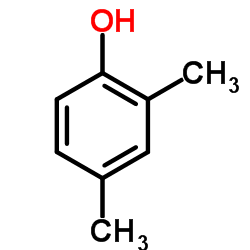Antimycoplasmal activity of dimethylphenols in a tracheal explant culture system.
C C Agee, J A Engelhardt, M G Gabridge
Index: Antimicrob. Agents Chemother. 18(2) , 243-8, (1980)
Full Text: HTML
Abstract
Mycoplasma pneumoniae induces pneumonia-like symptoms in hamsters and causes ciliostasis and cytonecrosis in hamster tracheal explants. 2,4-Dimethylphenol and, to a lesser extent, its 2,3-, 2,5-, and 2,6-dimethylphenol isomers protected tracheal explants from these changes after exposure to virulent M. pneumoniae strain PI 1428. The effect was concentration, time, and isomer dependent. At concentrations of 10(-9) M or greater, 2,4-dimethylphenol completely prevented the morphological (loss of ciliated cells) and biochemical (decreased dehydrogenase activity) changes normally observed after exposure to M. pneumoniae. Apparently, 2,4-dimethylphenol interfered with an early event in the infection process. Complete protection required that it be present during the first 2 h of exposure of the explants to the infecting mycoplasmas. These xylenols may prove to be useful tools for helping to define the mechanisms of pathogenesis in certain respiratory infections.
Related Compounds
| Structure | Name/CAS No. | Molecular Formula | Articles |
|---|---|---|---|
 |
2,4-xylenol
CAS:105-67-9 |
C8H10O |
|
Calculating virtual log P in the alkane/water system (log P(...
2005-05-05 [J. Med. Chem. 48 , 3269-79, (2005)] |
|
Cellular apoptosis and cytotoxicity of phenolic compounds: a...
2005-11-17 [J. Med. Chem. 48 , 7234-42, (2005)] |
|
Double salts of ionic-liquid-based surfactants in microextra...
2015-11-01 [Anal. Bioanal. Chem 407 , 8753-64, (2015)] |
|
QSAR study on permeability of hydrophobic compounds with art...
2007-06-01 [Bioorg. Med. Chem. 15 , 3756-67, (2007)] |
|
Analysis of phenolic compounds in the dissolved and suspende...
2015-08-01 [Environ. Sci. Pollut. Res. Int. 22 , 11966-74, (2015)] |